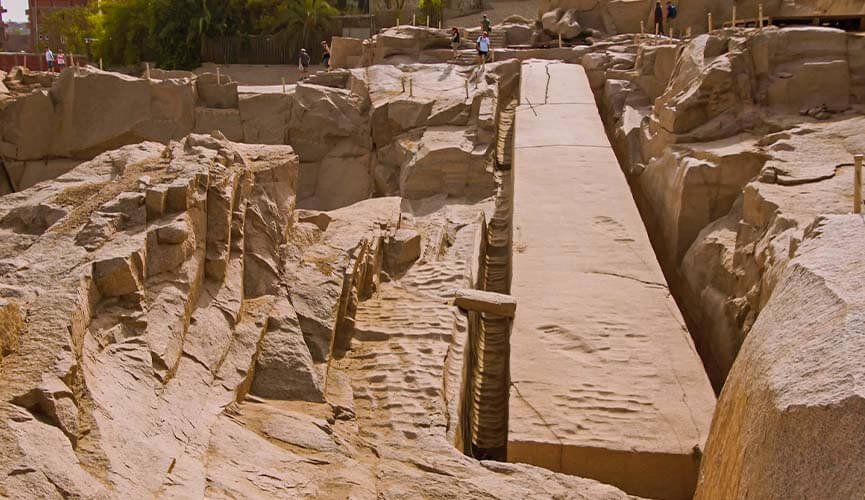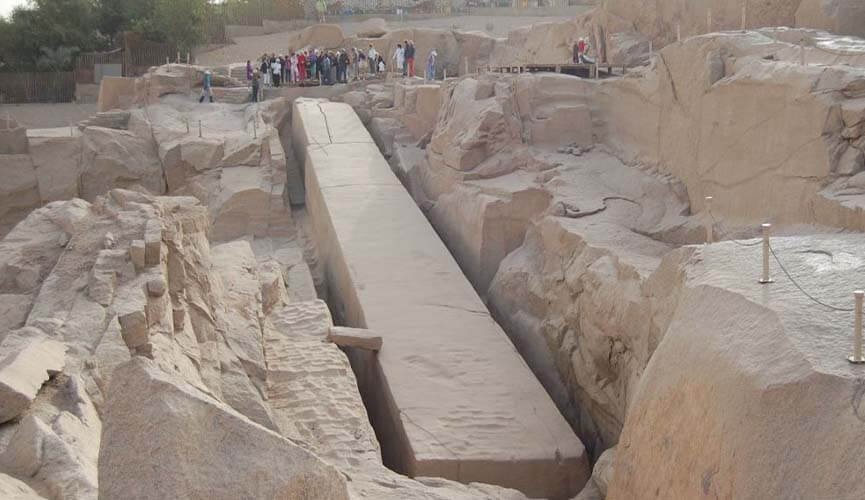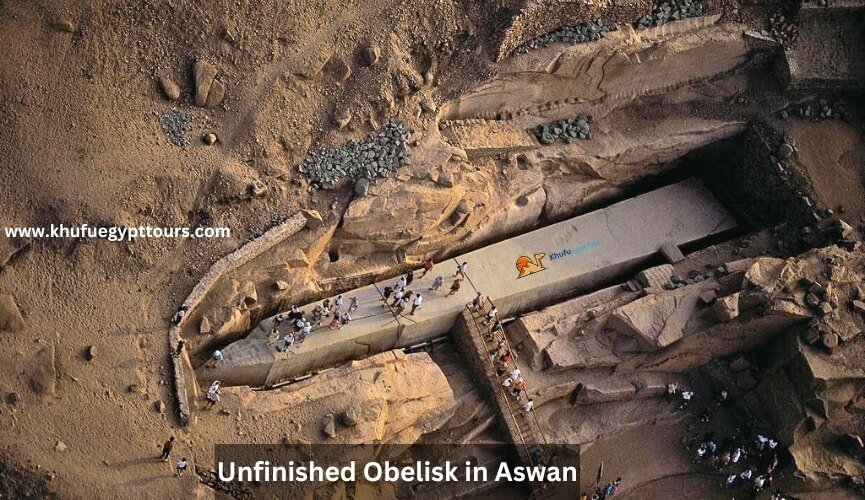The Unfinished Obelisk in Aswan is a striking example of ancient Egyptian ambition and engineering. This colossal monument, estimated to weigh around 1,200 tons, was commissioned during the reign of Hatshepsut (circa 15th century BC). Had it been completed, it would have been the tallest obelisk ever erected. However, a significant crack in the granite forced workers to abandon it, leaving behind an open-air museum that reveals how obelisks were crafted.
A visit to this historical site, the Aswan Unfinished Obelisk, provides a unique opportunity to see the marks left by ancient artisans and understand the incredible effort that went into carving these monolithic structures. If you plan a trip to Egypt, adding the Unfinished Obelisk Aswan to your itinerary offers a fascinating window into Egypt’s past.
You can see more of this historic city’s landmarks through our Aswan City Egypt
Key Takeaways
- The Unfinished Obelisk in Aswan is the largest known ancient obelisk, offering a rare glimpse into Egypt’s stone-carving techniques.
- This massive monument, abandoned due to cracks, remains partially attached to the bedrock in a granite quarry.
- It provides crucial insights into ancient Egyptian engineering, showcasing how workers used dolerite tools to carve granite.
- The site is a must-visit for history enthusiasts and travelers interested in Egypt’s architectural marvels.
- Visiting the Unfinished Obelisk can be combined with trips to Philae Temple and the High Dam for a well-rounded Aswan tour.
- Booking a guided tour enhances the experience, offering in-depth historical context and seamless transportation.
Historical Significance of the Unfinished Obelisk in Aswan

The Unfinished Obelisk offers more than just an abandoned project; it tells a story of ancient Egyptian engineering, craftsmanship, and ambition. Obelisks were typically quarried in Aswan’s granite fields before being transported to various locations, including Karnak Temple, Luxor Temple, and Heliopolis. The discovery of tool marks and carving techniques at the site has provided scholars with essential clues about how the Egyptians worked with granite.
Had the obelisk been completed, it would have stood over 42 meters (138 feet) tall, surpassing all known obelisks in size. The fact that such a massive project was attempted demonstrates the architectural prowess of ancient Egypt. Even in its incomplete state, the Unfinished Obelisk remains a monumental attraction that continues to captivate visitors.
How the Unfinished Obelisk Aswan Was Carved
The obelisk was carved directly out of the bedrock using an advanced technique for its time. Ancient Egyptians used dolerite hand tools, a type of extremely hard stone, to pound and chip away at the granite. Workers would carve trenches around the monolith, gradually detaching it from the surrounding rock. The process was slow and labor-intensive, requiring significant manpower.
The most intriguing aspect of the Unfinished Obelisk is the visible tool marks and unfinished sections, which clearly outline how the ancient quarrying process worked. The discovery of dolerite hammers in the quarry further confirms the methods used. If the project had been successful, the obelisk would have been smoothed and transported via the Nile River, much like the existing obelisks standing in major temples today.
Why Was the Unfinished Obelisk Abandoned?
A major crack developed in the granite during the carving process, making the obelisk structurally unstable. This flaw forced workers to leave the project incomplete, as continuing would have risked the monument breaking apart.
Instead of removing it from the quarry, the Unfinished Obelisk was left in place, allowing modern historians and visitors to witness an ancient construction project in progress. This natural fracture provides a rare insight into the challenges faced by ancient Egyptian builders and serves as a reminder that even the most skilled craftsmen encountered obstacles.
Location and How to Visit
The Unfinished Obelisk is located in the Northern Quarry of Aswan, just a short drive from the city center. It is easily accessible by taxi or as part of a guided tour that includes other Aswan highlights.
- Opening Hours: Daily from 7:00 AM to 5:00 PM
- Entrance Fee: Varies based on nationality (included in most guided tour packages)
- Best Time to Visit: Early morning or late afternoon to avoid the midday heat
Visiting with a knowledgeable guide enhances the experience, providing a deeper understanding of the site’s history and significance. Many travelers choose to combine their visit with stops at Philae Temple, Aswan High Dam, and Nubian Village for a well-rounded exploration of the city.
Interesting Facts About the Aswan Unfinished Obelisk

- It is one-third larger than any standing obelisk in the world.
- The site reveals the exact techniques used by ancient workers, making it an essential stop for archaeology enthusiasts.
- The nearby granite quarry supplied stone for many famous Egyptian monuments, including obelisks in Rome, Luxor, and London.
- The unfinished state of the obelisk provides an exclusive look into the challenges of ancient stone-cutting methods.
Why You Should Visit
If you’re planning a trip to Egypt, the Unfinished Obelisk is a must-see site that offers an unmatched perspective on ancient engineering and craftsmanship. Unlike temples and pyramids that showcase finished grandeur, this site allows you to step into an ongoing construction project frozen in time.
Visitors can walk along the trenches where workers once toiled, see the incomplete carvings, and appreciate the sheer scale of what could have been the tallest obelisk in history. Pairing this visit with a guided tour of Aswan ensures you get the most out of your experience.
Conclusion
The Unfinished Obelisk in Aswan is a remarkable testament to the skill and craftsmanship of the ancient Egyptians. It offers valuable insight into their advanced stone-cutting techniques and the challenges they faced. Visiting the site provides a unique opportunity to connect with Egypt’s rich history.

